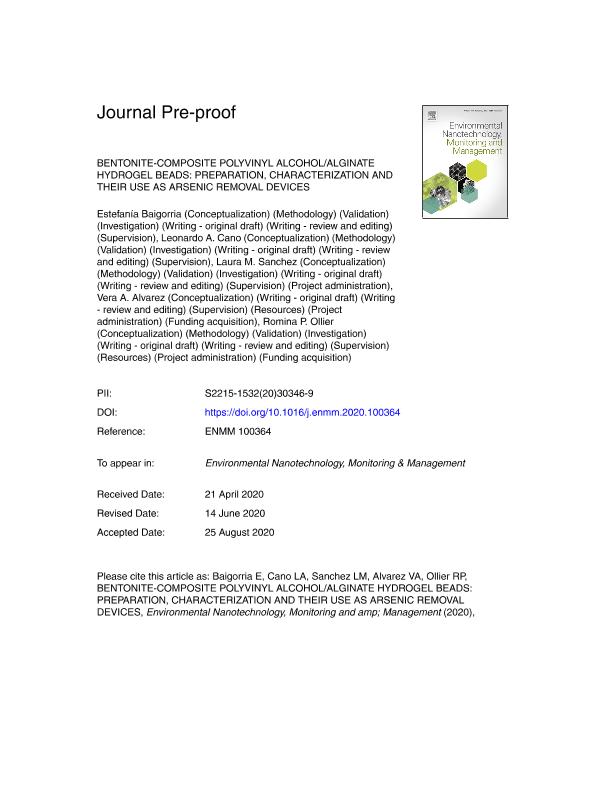Artículo
Bentonite-composite polyvinyl alcohol/alginate hydrogel beads: Preparation, characterization and their use as arsenic removal devices
Baigorria, Estefanía ; Cano, Leonardo Andres
; Cano, Leonardo Andres ; Sanchez, Laura Mabel
; Sanchez, Laura Mabel ; Alvarez, Vera Alejandra
; Alvarez, Vera Alejandra ; Ollier Primiano, Romina Paola
; Ollier Primiano, Romina Paola
 ; Cano, Leonardo Andres
; Cano, Leonardo Andres ; Sanchez, Laura Mabel
; Sanchez, Laura Mabel ; Alvarez, Vera Alejandra
; Alvarez, Vera Alejandra ; Ollier Primiano, Romina Paola
; Ollier Primiano, Romina Paola
Fecha de publicación:
12/2020
Editorial:
Elsevier
Revista:
Environmental Nanotechnology, Monitoring and Management
ISSN:
2215-1532
Idioma:
Inglés
Tipo de recurso:
Artículo publicado
Clasificación temática:
Resumen
Arsenic (As) is a major source of water contamination that has both natural and anthropogenic origins, so that, to remove it from water is a relevant topic. Taking into account the ease of operation, the cost of processing and the required instrumentation, adsorption processes could be considered as very convenient alternative technologies for water remediation. The present research work is focused on the development and characterization of eco-friendly polyvinyl alcohol (PVA) and alginate (Alg) hydrogel beads containing natural bentonite (Bent) as potential useful devices for As removal from polluted water. Composite beads with different PVA/Alg proportions (75/25 and 50/50) with and without 30 wt.% Bent were prepared by ionic gelation. The obtained beads were thoroughly characterized by means of thermal analysis (differential scanning calorimetry and thermogravimetric analysis), crosslinking degree by evaluating the gel fraction (GF), the capacity of swelling, morphological aspects (by Scanning Electron Microscopy), functional groups and interactions (by FTIR) and finally, the performance of the beads as arsenic adsorbent was tested by treating batch aqueous solutions. Morphological investigations showed that wet beads were highly porous and spherical. Moreover, the beads with the highest PVA content absorbed higher amounts of water whereas the incorporation of clay to the hydrogels produced a reduction on the swelling degree and an increase of GF. The adsorption behavior of the pearls towards As was studied in terms of PVA/Alg ratio, clay loading and contact time. The results clearly demonstrated that the clay inclusion plays a key role in the As removal since unfilled PVA/Alg beads were not able to remove it. The FTIR spectra of beads after As removal show the partial migration of the components of the beads, which can be associated with the intermediate crosslinking degree and almost amorphous state within the matrix.
Archivos asociados
Licencia
Identificadores
Colecciones
Articulos(INTEMA)
Articulos de INST.DE INV.EN CIENCIA Y TECNOL.MATERIALES (I)
Articulos de INST.DE INV.EN CIENCIA Y TECNOL.MATERIALES (I)
Citación
Baigorria, Estefanía; Cano, Leonardo Andres; Sanchez, Laura Mabel; Alvarez, Vera Alejandra; Ollier Primiano, Romina Paola; Bentonite-composite polyvinyl alcohol/alginate hydrogel beads: Preparation, characterization and their use as arsenic removal devices; Elsevier; Environmental Nanotechnology, Monitoring and Management; 14; 12-2020; 1-32
Compartir
Altmétricas



